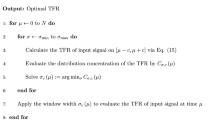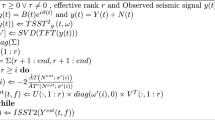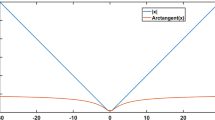Abstract
Seismic data may suffer to serious noise signal, therefore it’s necessary to further process and interpret it. In this passage, we proposed a new method about noise suppression for seismic data based on principal component analysis (PCA), including following four steps. Firstly, one-dimensional seismic signals are extended to multidimensional dataset. Secondly, to de-correlate the new dataset, we use Gaussian noises to whiten the generalized signals with the signal noise ratio (SNR) of noises equalling to the data SNR. Thirdly, with regard to the uncorrelated dataset, we execute random noise suppression using PCA technology from transform domains, which is spanned by the eigen-vector of the data co-variance matrix. Finally, interesting data of seismic data is changed back to time domain by corresponding inverse transform. We confirmed the effectiveness of the proposed method by simulation results of measurements data and seismic signals.




Similar content being viewed by others
References
Beckouche, S., & Ma, J. (2014). Simultaneous dictionary learning and denoising for seismic data. Geophysics, 79(3), A27–A31.
Bonar, D., & Sacchi, M. (2012). Denoising seismic data using the nonlocal means algorithm. Geophysics, 77, A5–A8.
Forghani-Arani, F., Haines, S., Batzle, M., Behura, J., & Davidson, M. (2012). Noise-suppression in surface microseismic data. The Leading Edge, 31, 1496–1501.
Chen, Yangkang, & Ma, Jitao. (2014). Random noise attenuation by f-x empirical-mode decomposition predictive filtering. Geophysics, 79(3), V81–V91.
Hennenfent, G., & Herrmann, F. (2006). Seismic denoising with nonuniformly sampled curvelets. Computing in Science and Engineering, 8, 16–25.
Hennenfent, G., Fenelon, L., & Herrmann, F. J. (2010). Nonequispaced curvelet transform for seismic data reconstruction: A sparsity-promoting approach. Geophysics, 75(6), WB203–WB210.
Oropeza, V., & Sacchi, M. (2011). Simultaneous seismic data denoising and reconstruction via multichannel singular spectrum analysis. Geophysics, 76(3), V25–V32.
Ibrahim, A., & Sacchi, M. D. (2014). Simultaneous source separation using a robust Radon transform. Geophysics, 79(1), V1–V11.
Xu, H.-Q., & Gui, Z.-X. (2014). Signal-to-noise ratio application to seismic marker analysis and fracture detection. Applied Geophysics, 11(1), 73–79.
Chen, Y.-P., Peng, Z.-M., He, Z.-H., Tian, L., & Zhang, D.-J. (2013). The optimal fractional gabor transform based on the adaptive window function and its application. Applied Geophy, 10(3), 305–313.
Liang, J., Ma, J., & Zhang, X. (2014). Seismic data restoration via data-driven tight frame. Geophysics, 79(3), V65–V74.
Zhai, M.-Y. (2014). Seismic data denoising based on the fractional Fourier transformation. Journal of Applied Geophysics, 109(10), 62–78.
Kazemi, N., & Sacchi, M. D. (2014). Sparse multichannel blind deconvolution. Geophysics, 79(5), V143–V152.
Pilikos, G., & Faul, A. C. (2017). Bayesian feature learning for seismic compressive sensing and denoising. Geophysics, 82, O91–O104.
Author information
Authors and Affiliations
Corresponding author
Rights and permissions
About this article
Cite this article
Ma, YJ., Zhai, MY. Random Noise Suppression Algorithm for Seismic Signals Based on Principal Component Analysis. Wireless Pers Commun 102, 653–665 (2018). https://doi.org/10.1007/s11277-017-5081-7
Published:
Issue Date:
DOI: https://doi.org/10.1007/s11277-017-5081-7




